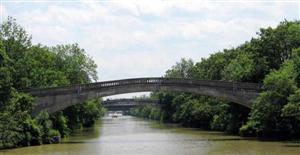Words of Wisdom from SharLeigh
CANAL OPENS UP OHIO VALLEY
When the United States was a new country there were vast amounts of land without ease of accessibility. Because of this fact, most people settled on the Eastern Seaboard. Even though the rivers, lakes and streams were a large portion of the landscape, they were used mostly by Indians, explorers, hunters and trappers for exploration and light trade. In the early 1800s, roads were few and far between and there was no railroad system. The government wanted to somehow connect the Eastern Seaboard to the Ohio Valley to encourage expansion of settlements and commerce inland but did not know how to do it. Necessity is always the mother of invention. In 1808 the famous Erie Canal was proposed. Governor DeWitt Clinton of New York broke ground for the canal in 1817 and it was completed in 1825. The canal connected the eastern waters of the Hudson River to the western waterway of Lake Erie. The work was accomplished by New Yorkers and European immigrants and was likened to the Eighth Wonder of the World! The entire canal was 363 miles long and included 83 hand-cut stone locks to accommodate the 568-foot rise in elevation. The canal was only four feet deep and 40 feet wide. One side of the bank had a 10-foot wide towpath where a hoggee (boat driver) would lead horses, mules or oxen to pull the boats along the water route. The canal was worth its weight in gold. Not only did it help to make New York a major port but it also created hamlets along the canal. These hamlets later became towns such as Utica, Rome, Syracuse, Rochester and Buffalo. The canal was an expedient and inexpensive way to encourage commerce and immigration into the Ohio Valley and beyond. So, again, we have another history lesson illustrating how transporting freight helped build this country and make it great! Today, the Erie Canal is part of the New York State Canal System, and is mainly used for recreation.
